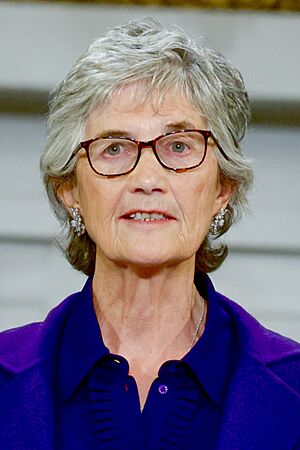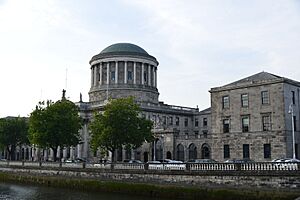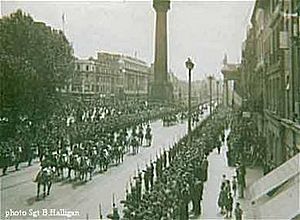President of Ireland facts for kids
The President of Ireland (Irish: Uachtarán na hÉireann) is the head of state for Ireland. This means the President is the main representative of the country. The President is also the supreme commander of the Irish Defence Forces, which are Ireland's armed forces.
The role of President was created by the Constitution of Ireland in 1937. The first President started their job in 1938. By 1949, the President was fully recognized around the world as Ireland's head of state. The President's official home and main office is Áras an Uachtaráin in Phoenix Park, Dublin.
The President's job is mostly ceremonial. This means they represent Ireland at home and abroad, like a symbol of the nation. However, the President also has some important powers. These powers help protect the Constitution of Ireland. The President promises to "maintain the Constitution of Ireland and uphold its laws."
Presidents serve for seven years. They can serve for a maximum of two terms. The people of Ireland vote directly for their President. However, if only one person is nominated, there is no need for an election. This has happened six times. Catherine Connolly became President on 11 November 2025. She won the 2025 Irish presidential election. She is the tenth person to hold this office and the third woman. Before her, Mary Robinson and Mary McAleese were also Presidents.
Quick facts for kids President of Ireland |
|
|---|---|

Presidential Standard
|
|
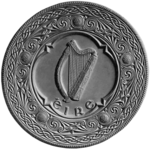
Presidential Seal
|
|
| Style | President (A Uachtaráin) or Your Excellency (A Shoilse) |
| Residence | Áras an Uachtaráin |
| Seat | Dublin, Ireland |
| Nominator | Members of the Oireachtas or local councils |
| Appointer | Direct popular vote by Instant-runoff voting |
| Term length | Seven years,
renewable once
|
| Constituting instrument | Constitution of Ireland (1937) Articles 12−14 |
| Precursor |
|
| Inaugural holder | Douglas Hyde |
| Formation | 25 June 1938 |
| Salary | €249,014 annually |
Contents
History of the Presidency
The office of President was created in 1937. It replaced a role called the Governor-General, which existed when Ireland was the Irish Free State (1922–1937). The idea for a seven-year term came from the presidents of Germany at that time.
Ireland's Head of State: A Clearer Role
From 1937 to 1949, there was some confusion about who was truly Ireland's head of state. This confusion ended in 1949 when Ireland was officially declared a republic. The Republic of Ireland Act 1948 made it clear that the President represented Ireland in its dealings with other countries.
How the President's Role Changed
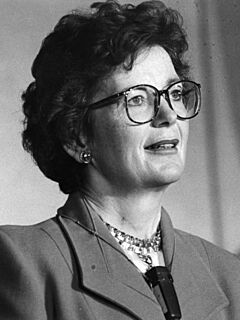
After the first President, Douglas Hyde, most Presidents were nominated by the Fianna Fáil political party. These early Presidents usually kept a quiet, mostly ceremonial role. They used their powers carefully.
However, the presidency has seen some important moments. In 1976, President Cearbhall Ó Dálaigh resigned after a disagreement with the government. Later, in 1982, President Patrick Hillery showed great strength. He refused to let politicians pressure him into making a decision about dissolving the Dáil (Ireland's parliament). This showed the dignity and independence of the office.
The role truly changed in the 1990s with President Mary Robinson. She was the first woman President and the first not from Fianna Fáil. President Robinson made the office more active. She worked to build new connections between Ireland and other countries. She also used her position to highlight important issues, like poverty in developing countries. Her successor, Mary McAleese, continued this active role. Since 2019, the President has attended meetings with other European non-executive presidents.
How the President is Chosen and Serves
Presidential Elections
The President is chosen by a direct vote of the people. This is done using a secret ballot. Voters use a system called instant-runoff voting, where they rank candidates in order of preference.
An election happens so that the new President can start their term the day after the previous President's seven-year term ends. If the President's office becomes empty early, a new election must be held within sixty days.
To vote, you must be an Irish citizen and at least eighteen years old. To be a candidate for President, you must be an Irish citizen and over 35 years old.
A President can serve for a maximum of two terms. Candidates can be nominated in a few ways:
- By at least 20 members of the Oireachtas (Ireland's parliament).
- By at least four county or city councils.
- A current or former President who has served one term can nominate themselves.
If only one person is nominated, that person becomes President without a vote. This has happened six times since the office was created.
The most recent presidential election was held on 24 October 2025.
When There is No President
Ireland does not have a Vice President. If the President's office becomes empty early, or if the President is away, a special group called the Presidential Commission takes over. This group includes the Chief Justice, the speaker of the Dáil (called the Ceann Comhairle), and the chairperson of the Seanad (called the cathaoirleach). They handle the President's duties until a new President is elected. For example, they often sign bills into law when the President is on a state visit abroad.
The term of an outgoing President ends at midnight on the day the new President is inaugurated. So, for a few hours, the Presidential Commission handles duties until the new President is sworn in.
The presidency has become vacant three times: when Erskine Hamilton Childers passed away in 1974, and when Cearbhall Ó Dálaigh (1976) and Mary Robinson (1997) resigned.
Removing a President from Office
A President can be removed from office in two ways, but neither has ever been used. 1. The Supreme Court can decide if a President is "permanently incapacitated" (unable to do their job). 2. The Oireachtas (parliament) can remove a President for "stated misbehaviour." This involves a detailed process where both houses of parliament must agree.
What the President Does
Ireland has a parliamentary system of government. This means the President's role as head of state is mostly ceremonial. The President is formally part of the Oireachtas (national parliament), along with the Dáil (lower house) and the Seanad (upper house).
The main executive power in Ireland belongs to the Government (also known as the Cabinet). However, the Government must keep the President informed about important national and international matters. Most of the President's duties are carried out according to the Constitution or on the advice of the Government. But the President also has some special powers they can use independently.
Key Constitutional Duties
Here are some of the President's main duties:
- Appoint the Government: The taoiseach (Ireland's head of government) and other ministers make up the Government. The President formally appoints them after they are chosen by the Dáil.
- Appoint Judges: The President appoints judges to all courts in Ireland. This is done on the advice of the Government.
- Appoint State Officers: The President appoints the Attorney General (the government's chief legal advisor) and the Comptroller and Auditor General (who checks government spending).
- Convene and Dissolve the Dáil: The President starts and ends sessions of the Dáil (parliament). This is usually done on the advice of the Taoiseach. The President can refuse to dissolve the Dáil if the Taoiseach has lost the support of parliament.
- Sign Bills into Law: When the Dáil and Seanad pass a new law, the President signs it to make it official. The President cannot stop a bill from becoming law. However, they can ask the Supreme Court to check if a bill follows the Constitution. If the Court says it's unconstitutional, the bill cannot become law.
- Represent Ireland Abroad: The President represents Ireland in other countries. They welcome foreign diplomats and make state visits.
- Supreme Commander of the Defence Forces: The President is the supreme commander of the Irish Defence Forces. This is a symbolic role, and the Government makes the actual decisions about the armed forces.
- Exercise the Prerogative of Mercy: The President has the power to pardon someone or reduce their punishment. This is done on the advice of the Government.
Other Important Roles
In addition to constitutional duties, the President also:
- Appoints State Officials: The President appoints various other officials, like the governor of the Central Bank of Ireland.
- Supports Charities: The President is often a patron of many charities in Ireland. For example, the President is the head of the Irish Red Cross Society and Gaisce – The President's Award, which encourages young people to achieve personal goals.
- Awards Honours: The President gives the title of Saoi for life to distinguished Irish artists.
Special Rules for the President
- The President needs the Government's permission to leave Ireland.
- Any formal message the President sends "to the nation" or to parliament must first be approved by the Government. However, the President can give many other speeches without this approval. By tradition, Presidents do not directly criticize the Government.
Special Powers of the President
The President has some special powers that they can use independently. These are called "reserve powers."
Powers Used Independently
- Refusing to Dissolve the Dáil: If the Taoiseach (head of government) loses the support of parliament, they must resign. However, they can ask the President to dissolve the Dáil, which means calling a new election. The President has the power to refuse this request. If the President refuses, the Taoiseach must resign. This power has never been used.
- Appointing Council of State Members: The President appoints some members to the Council of State, a group that advises the President.
Powers Used After Consulting Advisors
Before using some other special powers, the President must talk with the Council of State. The President doesn't have to follow their advice, but must listen to it.
- Referring Bills to the Supreme Court: The President can send a new law (a bill) to the Supreme Court to check if it follows the Constitution. This is a common use of the President's special powers.
- Referring Bills to the People: If a majority of the Seanad (upper house) and one-third of the Dáil (lower house) ask, the President can decide not to sign an important bill into law until the people vote on it in a referendum. This power has never been used.
- Ensuring Parliament Works: The President has powers to help make sure the Oireachtas (parliament) works smoothly. For example, they can set a time limit for the Seanad to consider a bill if the Dáil requests it.
- Communicating with the Nation: The President can send messages to the Oireachtas or "to the Nation." These messages need government approval.
Presidential Privileges
Official Residence and Honours
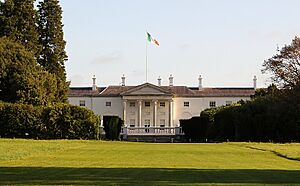
The President's official home is Áras an Uachtaráin, located in Phoenix Park in Dublin. This large building has 92 rooms. The President is usually called 'President' or 'Uachtarán'. People might also address the President as 'Your Excellency' (Irish: A Shoilse). The Presidential Salute is a special musical piece taken from the National Anthem, "Amhrán na bhFiann".
Inauguration Ceremony
The inauguration ceremony is when the new President officially takes office. It happens the day after the previous President's term ends. All inaugurations have taken place in Saint Patrick's Hall in Dublin Castle. This important event is shown live on national television and radio. Key figures from the government, parliament, and courts attend, along with diplomats and other guests.
The President takes an oath of office in public. This is a formal promise to serve the country.
Salary and Expenses
The President receives an official salary and an allowance for expenses. The salary is currently €249,014 per year. The President also receives an additional €317,434 for expenses. The Constitution protects the President's salary, meaning it cannot be reduced during their term in office.
Security and Transport
As head of state, the President receives the highest level of protection in Ireland. Áras an Uachtaráin is guarded by armed police and military personnel. When the President travels, they are always accompanied by an armed security team from the Special Detective Unit (SDU), an elite police force.
The President travels in a special limousine, a dark navy blue Mercedes-Benz S-Class. This car displays the presidential standard and the tricolour flags. Support cars and police motorcycle escorts always accompany the presidential limousine, forming a protective convoy.
For ceremonial events, like the inauguration, the President is escorted by the Presidential Motorcycle Escort. In the past, this escort was made up of cavalry on horseback, known as the Blue Hussars. The President also has access to Irish Air Corps aircraft, including helicopters and private jets, for travel.
List of Presidents of Ireland
The Presidential Commission carried out the duties of the President from 29 December 1937 until Douglas Hyde was elected in 1938. They also stepped in during vacancies in 1974, 1976, and 1997.
| No. | Portrait | Name (Birth–Death) |
Previous service | Term of office | Nominated by | Election | |||
|---|---|---|---|---|---|---|---|---|---|
| Took office | Left office | Time in office | |||||||
| 1 |
|
Douglas Hyde (1860–1949) |
Senator (1922–1925, 1938) |
25 June 1938 | 24 June 1945 | 7 years | Fianna Fáil | 1938 | |
| Fine Gael | |||||||||
| 2 |
|
Seán T. O'Kelly (1882–1966) |
Tánaiste (1932–1945) |
25 June 1945 | 24 June 1959 | 14 years | Fianna Fáil | 1945 | |
| Himself | 1952 | ||||||||
| 3 |
|
Éamon de Valera (1882–1975) |
Taoiseach (1932–1948, 1951–1954, 1957–1959) |
25 June 1959 | 24 June 1973 | 14 years | Fianna Fáil | 1959 | |
| 1966 | |||||||||
| 4 | Erskine Hamilton Childers (1905–1974) |
Tánaiste (1969–1973) |
25 June 1973 | 17 November 1974 | 1 year, 145 days | Fianna Fáil | 1973 | ||
| 5 |
|
Cearbhall Ó Dálaigh (1911–1978) |
Chief Justice of Ireland (1961–1973) |
19 December 1974 | 22 October 1976 | 1 year, 308 days | Fianna Fáil | 1974 | |
| Fine Gael | |||||||||
| Labour | |||||||||
| 6 |
|
Patrick Hillery (1923–2008) |
European Commissioner for Social Affairs (1973–1976) |
3 December 1976 | 2 December 1990 | 14 years | Fianna Fáil | 1976 | |
| Himself | 1983 | ||||||||
| 7 |
|
Mary Robinson (born 1944) |
Senator (1969–1989) |
3 December 1990 | 12 September 1997 | 6 years, 283 days | Labour | 1990 | |
| Workers' Party | |||||||||
| 8 |
|
Mary McAleese (born 1951) |
Reid Professor of Criminal law, Criminology and Penology at Trinity College Dublin |
11 November 1997 | 10 November 2011 | 14 years | Fianna Fáil | 1997 | |
| Progressive Democrats | |||||||||
| Herself | 2004 | ||||||||
| 9 |
|
Michael D. Higgins (born 1941) |
Minister for Arts, Culture and Gaeltacht (1993–1997) |
11 November 2011 | 10 November 2025 | 13 years | Labour | 2011 | |
| Himself | 2018 | ||||||||
| 10 |
|
Catherine Connolly (born 1957) |
Leas-Cheann Comhairle (2020–2024) |
11 November 2025 | Incumbent | 41 days | Sinn Féin | 2025 | |
| Labour | |||||||||
| Social Democrats | |||||||||
| People Before Profit–Solidarity | |||||||||
| Green | |||||||||
| 100% Redress | |||||||||
| Independent politician | |||||||||
Former presidents who are able and willing to act are members of the Council of State.
Images for kids
-
President Michael D. Higgins with the Chief Justice and Presidents of the Supreme Courts of Ireland
See also
 In Spanish: Presidente de Irlanda para niños
In Spanish: Presidente de Irlanda para niños
- President of the Irish Republic
- Gaisce – The President's Award
- Seal of the president of Ireland
- Presidential standard of Ireland
- Secretary-General to the President (Ireland)
- Warrant of appointment


